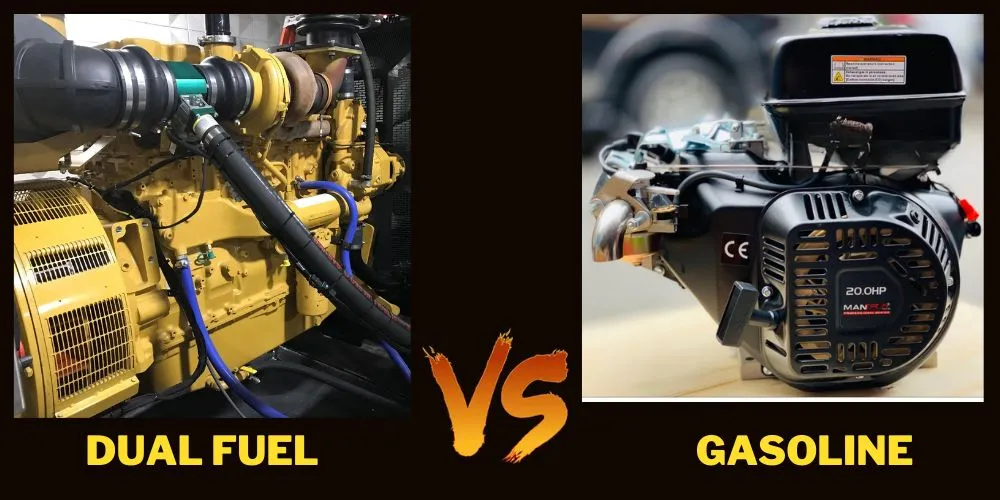As the world progresses towards more sustainable solutions, the debate between dual fuel and gasoline engines remains pertinent.
This dual fuel vs gasoline guide explores the nuances of both systems, helping users make informed decisions based on efficiency, cost, and environmental impact.

Understanding Dual Fuel Engines
Dual fuel engines operate by using two types of fuel, usually a combination of diesel and a gas, such as natural gas or biogas.
The primary fuel, often diesel, is used to initiate combustion, followed by the introduction of gas which burns alongside the diesel. This combination allows for improved fuel efficiency and a reduction in harmful emissions.
The advantages of dual fuel engines are significant. They can reduce nitrogen oxide emissions and particulate matter, both of which are harmful pollutants.
Moreover, the flexibility in fuel choice can lead to cost savings, especially in regions where gas is cheaper than diesel.
The Basics of Gasoline Engines
Gasoline engines function through the combustion of gasoline, a refined petroleum product. These engines ignite gasoline using a spark from the spark plug, which in turn powers the vehicle.

Known for their simplicity and high performance, gasoline engines have powered automobiles for decades. The benefits of gasoline engines include higher RPMs and the ability to generate more horsepower relative to size.
However, they tend to be less fuel-efficient and produce more emissions compared to dual fuel and other engine types.
Dual Fuel vs Gasoline: An In-Depth Comparison
When evaluating fuel efficiency, dual fuel engines often outperform gasoline engines. They make use of the efficiency of diesel combustion along with the cleaner properties of gas, providing a balanced approach to power generation.
Gasoline engines, while efficient in their rights, often consume more fuel and produce more CO2 emissions.
Cost is another crucial factor. The initial investment in dual fuel technology can be higher than that for a standard gasoline setup.
However, the operational costs might be lower with dual fuel engines due to the potential for using less expensive gases.
The environmental impact of dual fuel engines is generally less adverse than that of gasoline engines. By combining gases that burn cleaner, dual fuel systems reduce the overall pollutant output.
In contrast, gasoline engines produce higher levels of carbon dioxide, contributing to greenhouse gas emissions.
Performance analysis between the two engines shows that gasoline engines typically provide more raw power.
However, dual fuel engines offer a more sustainable performance, which can be particularly beneficial in applications where emission regulations are strict.
Pros and Cons
Dual Fuel Engines
The benefits of dual fuel engines extend beyond environmental perks. They offer versatility in fuel use, which can be crucial in areas with fluctuating fuel prices. However, their complexity in design and fuel system can be a hurdle in terms of maintenance and initial setup.
Gasoline Engines
The main advantage of gasoline engines is their unmatched performance in terms of speed and power output.
They are also generally easier to maintain due to their less complex structure. On the downside, their environmental impact and lower fuel efficiency can be significant drawbacks.
Technological Innovations and Developments
Recent advancements in dual fuel engine technologies have centered on improving efficiency and reducing emissions.
Innovations such as dynamic fuel blending systems allow for optimal use of both diesel and natural gas, adjusting in real-time to changes in engine load and conditions.
This leads to significant improvements in fuel efficiency and a drastic reduction in CO2 emissions.
Additionally, the development of advanced combustion control systems helps in achieving lower nitrogen oxide (NOx) levels, meeting stringent environmental standards.
On the gasoline engine front, direct injection technology has revolutionized performance by delivering fuel more precisely to the combustion chamber. This not only enhances power output but also increases fuel economy and reduces emissions.
Variable valve timing and cylinder deactivation are other notable innovations that contribute to the significant leap in efficiency and sustainability of gasoline engines.
These technological strides not only bolster engine performance but also align with global efforts towards environmental sustainability, demonstrating the auto industry’s commitment to cleaner, more efficient transportation solutions.
Market Trends and Predictions
The automotive and transport sector is increasingly leaning towards sustainability, with a noticeable shift towards engines that are both fuel-efficient and environmentally friendly.
Hybrid powertrains and dual fuel engines are gaining traction as transitional solutions before a full shift to zero-emission alternatives.
These trends reflect consumer demand for lower operating costs and a collective push for adherence to global emissions targets.
As electric vehicle (EV) technology matures and infrastructure develops, predictions suggest a decline in the traditional gasoline engine’s market share, while dual fuel engines maintain relevance in heavy-duty and industrial applications where electrification poses greater challenges.
We can expect tighter emissions regulations to fast-track the adoption of cleaner engine technologies, with increased incentives for low-carbon alternatives.
Such regulations will likely drive further innovation in both dual fuel and alternative propulsion systems, steadily reshaping the transportation landscape towards a greener future.
Frequently Asked Questions (FAQs)
What is more cost-effective in the long term: dual fuel or gasoline engines?
In the long run, dual fuel engines may offer more cost-effectiveness, especially if the secondary fuel used is significantly cheaper than gasoline. Moreover, the potential savings from reduced environmental taxes and fines can affect overall costs.
How do dual fuel engines help in reducing environmental impact?
Dual fuel engines reduce environmental impact by lowering the amount of particulate matter and nitrogen oxides released into the atmosphere. These engines utilize a cleaner secondary fuel, which burns more completely and produces fewer emissions.
Can I convert my existing gasoline engine to dual fuel?
Conversion from gasoline to dual fuel is possible but involves complex modifications. It requires the addition of a secondary fuel system and various engine adjustments to handle the dual fuel process.
Conclusion:
Choosing between dual fuel and gasoline engines involves weighing considerations of cost, efficiency, performance, and environmental impact.
Dual fuel engines offer an eco-friendlier alternative to traditional gasoline engines, with potential for greater long-term savings and reduced emissions.
However, for applications requiring high power output and simpler mechanics, gasoline engines might be preferable.
This guide serves to aid your decision-making process, ensuring you choose an engine that meets both your performance needs and ecological considerations.
